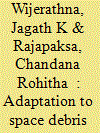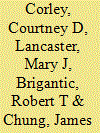|
|
|
Sort Order |
|
|
|
Items / Page
|
|
|
|
|
|
|
| Srl | Item |
| 1 |
ID:
152390


|
|
|
|
|
| Summary/Abstract |
Space exploration is a mechanism whereby, with the use of astronomy and space technology, humans are able to explore outer space and the universe at large. In this article, the authors address space debris issues with a discussion of future space law issues along with a brief elaboration of how the adaptation took place for space debris mitigation guidelines. The history of space law formulated during the United Nations’ General Assembly is justified, along with the resolutions that took place throughout recent years. The authors also elaborate on the importance of theoretical modeling and how it could be adopted into practice utilizing the established debris mitigation guidelines. Legal and political constraints are also highlighted, along with where the future focus on legal factors should be when considering space debris mitigation.
|
|
|
|
|
|
|
|
|
|
|
|
|
|
|
|
| 2 |
ID:
126220


|
|
|
|
|
| Publication |
2012.
|
| Summary/Abstract |
This research follows the Updated Guidelines for Evaluating Public Health Surveillance Systems, Recommendations from the Guidelines Working Group, published by the Centers for Disease Control and Prevention nearly a decade ago. Since then, models have been developed and complex systems have evolved with a breadth of disparate data to detect or forecast chemical, biological, and radiological events that have a significant impact on the One Health landscape. How the attributes identified in 2001 relate to the new range of event-based biosurveillance technologies is unclear. This article frames the continuum of event-based biosurveillance systems (that fuse media reports from the internet), models (ie, computational that forecast disease occurrence), and constructs (ie, descriptive analytical reports) through an operational lens (ie, aspects and attributes associated with operational considerations in the development, testing, and validation of the event-based biosurveillance methods and models and their use in an operational environment). A workshop was held in 2010 to scientifically identify, develop, and vet a set of attributes for event-based biosurveillance. Subject matter experts were invited from 7 federal government agencies and 6 different academic institutions pursuing research in biosurveillance event detection. We describe 8 attribute families for the characterization of event-based biosurveillance: event, readiness, operational aspects, geographic coverage, population coverage, input data, output, and cost. Ultimately, the analyses provide a framework from which the broad scope, complexity, and relevant issues germane to event-based biosurveillance useful in an operational environment can be characterized.
|
|
|
|
|
|
|
|
|
|
|
|
|
|
|
|
|
|
|
|
|